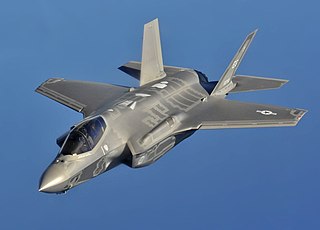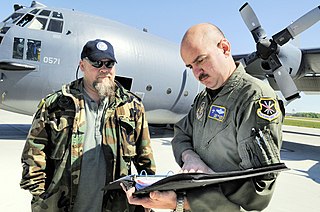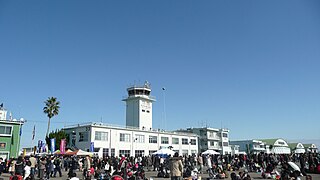
The General Dynamics F-16 Fighting Falcon is an American single-engine supersonic multirole fighter aircraft originally developed by General Dynamics for the United States Air Force (USAF). Designed as an air superiority day fighter, it evolved into a successful all-weather multirole aircraft with over 4,600 built since 1976. Although no longer purchased by the U.S. Air Force, improved versions are being built for export. In 1993, General Dynamics sold its aircraft manufacturing business to the Lockheed Corporation, which became part of Lockheed Martin after a 1995 merger with Martin Marietta.

The Lockheed Martin F-35 Lightning II is an American family of single-seat, single-engine, all-weather stealth multirole combat aircraft that is intended to perform both air superiority and strike missions. It is also able to provide electronic warfare and intelligence, surveillance, and reconnaissance capabilities. Lockheed Martin is the prime F-35 contractor, with principal partners Northrop Grumman and BAE Systems. The aircraft has three main variants: the conventional takeoff and landing (CTOL) F-35A, the short take-off and vertical-landing (STOVL) F-35B, and the carrier-based (CV/CATOBAR) F-35C.

The Lockheed Martin/Boeing F-22 Raptor is an American single-seat, twin-engine, supersonic all-weather stealth fighter aircraft developed for the United States Air Force (USAF). As a product of the USAF's Advanced Tactical Fighter (ATF) program the aircraft was designed as an air superiority fighter, but also incorporates ground attack, electronic warfare, and signals intelligence capabilities. The prime contractor, Lockheed Martin, built most of the F-22's airframe and weapons systems and conducted final assembly, while program partner Boeing provided the wings, aft fuselage, avionics integration, and training systems.

The Hellenic Air Force is the air force of Greece. Under the Kingdom of Greece from 1935 to 1973, it was previously known as the Royal Hellenic Air Force (RHAF).

The Lockheed F-94 Starfire was a first-generation jet powered all-weather day/night interceptor aircraft designed and produced by Lockheed Corporation. It was the first operational United States Air Force (USAF) fighter equipped with an afterburner as well as being the first jet-powered all-weather fighter to enter combat during the Korean War.

Iven Carl "Kinch" Kincheloe Jr. was an American pilot. He served in the U.S. Air Force during the Korean War, in which he was recognized as a flying ace. He continued as a test pilot after the war, participating in the Bell X-2 program, in which he set an altitude record of 126,200 feet (38,470 m) in 1956. For this suborbital flight above most of the atmosphere, he became known as "The First Spaceman". He was selected for the Air Force's program to put a man in space, but was killed in a plane crash in 1958.

The Belgian Air Component is the air arm of the Belgian Armed Forces, and until January 2002 it was officially known as the Belgian Air Force. It was founded in 1909 and is one of the world's oldest air services.

The Canadair CF-104 Starfighter is a modified version of the Lockheed F-104 Starfighter supersonic fighter aircraft built in Canada by Canadair under licence. It was primarily used as a ground attack aircraft, despite being designed as an interceptor. It served with the Royal Canadian Air Force (RCAF) and later the Canadian Armed Forces (CAF) until it was replaced by the McDonnell Douglas CF-18 Hornet.

A fighter pilot or combat pilot is a military aviator trained to engage in air-to-air combat, air-to-ground combat and sometimes electronic warfare while in the cockpit of a fighter aircraft. Fighter pilots undergo specialized training in aerial warfare and dogfighting. A fighter pilot with at least five air-to-air kills becomes known as an ace.

The 944th Fighter Wing is an Air Reserve component of the United States Air Force. It is assigned to Tenth Air Force, Air Force Reserve Command, stationed at Luke Air Force Base, Arizona.

The 58th Special Operations Wing is a combat unit of the United States Air Force stationed at Kirtland Air Force Base, New Mexico. The 58 SOW is part of the Air Education and Training Command (AETC) Nineteenth Air Force.

The 310th Fighter Squadron is part of the 56th Operations Group at Luke Air Force Base, Arizona. It operates the Lockheed Martin F-35A Lightning II, conducting advanced fighter training.

The 425th Fighter Squadron is part of the 56th Operations Group at Luke Air Force Base, Arizona. It operates the General Dynamics F-16 Fighting Falcon aircraft conducting advanced fighter training for Republic of Singapore Air Force F-16 pilots.

The 418th Test and Evaluation Squadron is an active United States Air Force unit assigned to the 53rd Test and Evaluation Group, and stationed at Davis-Monthan Air Force Base, Arizona, where it was activated on 1 October 2021.

The 339th Flight Test Squadron is a United States Air Force unit based at Robins Air Force Base, Georgia. It is part of the Warner Robins Air Logistics Center, with a mission to certify aircraft as worthy to return to service. The squadron is responsible for conducting flight tests on the Lockheed C-130 Hercules, the Lockheed C-5 Galaxy and McDonnell Douglas F-15 Eagle after program depot maintenance is completed.

Nyutabaru Air Base is a military aerodrome of the Japan Air Self-Defense Force (JASDF). It is located in the town of Shintomi, approximately 10.5 NM north of the city Miyazaki in Miyazaki Prefecture, Japan, on the eastern coast of Kyushu. It is the headquarters for the JASDF 5th Air Wing. It is also known as the former home of the flight instruction group, which was made up of the most highly skilled pilots in Japan. The base area is 9,135 square kilometres (3,527 sq mi).

Aerial ramming or air ramming is the ramming of one aircraft with another. It is a last-ditch tactic in air combat, sometimes used when all else has failed. Long before the invention of aircraft, ramming tactics in naval warfare and ground warfare were common. The first aerial ramming was performed by Pyotr Nesterov in 1914 during the First World War. In the early stages of World War II the tactic was employed by Soviet pilots, who called it taran, the Russian word for "battering ram".
Hispanics in the United States Air Force can trace their tradition of service back to the United States Army Air Forces (USAAF), the military aviation arm of the United States Army during and immediately after World War II. The USAAF was the predecessor of the United States Air Force, which was formed as a separate branch of the military on September 18, 1947, under the National Security Act of 1947. In the U.S., the term Hispanic categorizes any citizen or resident of the United States, of any racial background, of any country, and of any religion, who has at least one ancestor from the people of Spain or is of non-Hispanic origin but has an ancestor from Mexico, Puerto Rico, Cuba, Central or South America, or some other Hispanic origin. The three largest Hispanic groups in the United States are the Mexican-Americans, Puerto Ricans, and Cubans. According to the U.S. Census Bureau the estimated Hispanic population of the United States is over 50 million, or 16% of the U.S. population, and Hispanics are the nation's largest ethnic minority. The 2010 U.S. census estimate of over 50 million Hispanics in the U.S. does not include the 3.9 million residents of Puerto Rico, thereby making the people of Hispanic origin the nation's largest ethnic or race minority as of July 1, 2005.

Marc Henry Sasseville Frontera is a United States Air Force lieutenant general who currently serves as the 12th Vice Chief of the National Guard Bureau. He previously served as the commander of the Continental United States North American Aerospace Defense Command Region and concurrently as commander of the First Air Force from June 2019 to August 2020. Sasseville previously served as commander of the 113th Wing, District of Columbia Air National Guard at Andrews Air Force Base in Maryland and was the first Hispanic American to hold the position.

Collaborative combat aircraft (CCA) is a US program for unmanned combat air vehicles (UCAVs) that is considered broadly equivalent to a loyal wingman. CCAs are intended to operate in collaborative teams with the next generation of manned combat aircraft, including sixth-generation fighters and bombers such as the Northrop Grumman B-21 Raider. Unlike the conventional UCAVs, the CCA incorporates artificial intelligence (AI), denoted an "autonomy package", increasing its survivability on the battlefield. It is still expected to cost much less than a manned aircraft with similar capabilities. The US Air Force plans to spend more than $6 billion on its CCA programs from 2023 to 2028. The success of the CCA program may lessen the need for additional manned squadrons.



















